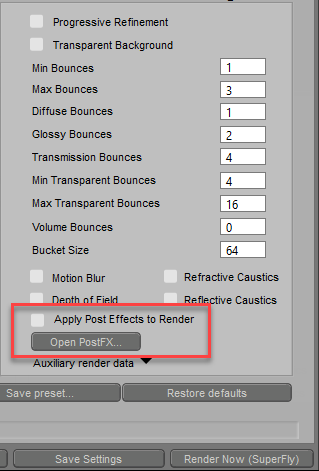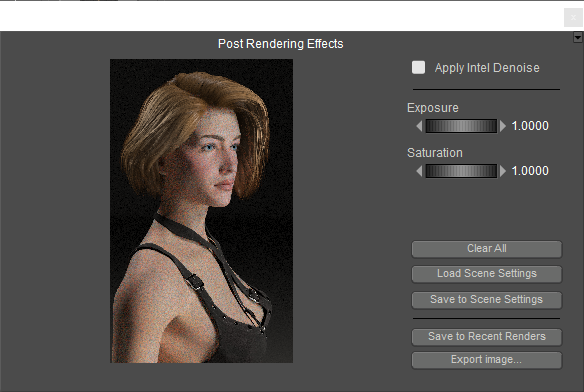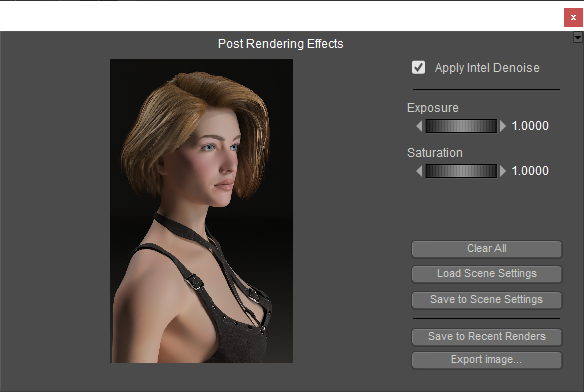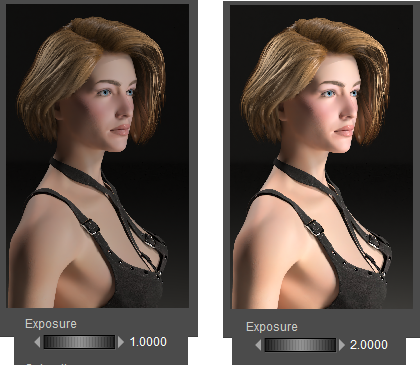Applying Post Effects to Renders
There’s often a trade-off between rendering speed and rendering quality. If you set render quality settings too low, the renders will finish more quickly, but they will contain a lot of noise. If you set your render quality settings very high, your renders will take a much longer time, but will be very sharp and clean.
There is a way to compromise. If you set your render settings in the middle range, and then use the denoising filter provided with PostFX, you can obtain very good render results in a more reasonable amount of time.
To enable Post Effects in SuperFly, open the Render Settings dialog to the SuperFly tab. Check the Apply Post Effects to Render option, and then click the Open PostFX button to check the default post effects you want to apply to your render.

Post Effects option and button.
When you open the PostFX window from the Render Settings dialog, the following screen appears. This allows you to choose which post effects options and settings to use by default. The Apply Intel Denoise, Exposure, and Saturation settings are described below.
The settings you apply here can be applied when you render animations using the Movie Settings window in Render Settings, or when you use the Animation > Make Movie command. For example, to render an image sequence, choose Image Files format, and then select SuperFly for the renderer.
If your images are rendered against a transparent background, export PNG format to preserve transparency. Images will be exported with an alpha channel.

Post Effects settings.
A PostFX button also appears in the top center of the Render tab, as shown below. You can click this button to apply postfx to the render that is currently in the Render window (which is, by default, your most recent render). Click this button to open the Post Rendering Effects dialog.
![]()
PostFX icon.
When the Post Rendering Effects dialog appears, you will see a render preview in the window. By default, the last render that you completed will appear in the preview. You can also click any render thumbnail in the Recent Renders palette, and click the PostFX button in the center of the options above the Render window to open the Post Rendering Effects window.
You can use this preview to view how the post rendering affects will affect your selected render. The following example shows the preview of a figure that was rendered with Medium Adaptive (GPU) render preset.

Post Rendering Effects window (denoising not applied).
The options are:
- Apply Intel Denoise: Check this option to apply the denoising filter at the end of the render. The preview window will update with a preview of the denoised render.

Denoised Preview.
- Exposure: Increase or decrease the Exposure slider to adjust image exposure.

Original (left) vs Post Effects Exposure adjustment (right).
- Saturation. Use the Saturation slider to adjust the saturation of the image. Moving the slider or entering a value of zero will generate a grayscale image.

Original (left) vs Post Effects Saturation adjustment (right).
- Clear All: Returns all post rendering effects settings to their default value.
- Load Scene Settings: When you restart Poser, the Post Rendering Effects window starts up with the default settings. If you open a scene that has had post effects settings saved (with the Save to Scene Settings button below) you can reset the post effects to those saved values with this button.
- Save to Scene Settings: Click to apply the settings from the Post Effects window to your current scene. The post effects setting will be saved with the scene.
- Save to Recent Renders: Click this button to save the render with the post effects applied to your Recent Renders palette. From there you can export the image to any supported image format.
- Export Image: Click this button to save the image to a location on your hard drive. Poser will save the image that has post effects applied with the file name that you enter. The original rendered image (without post effects applied) will be saved as filename_Original.